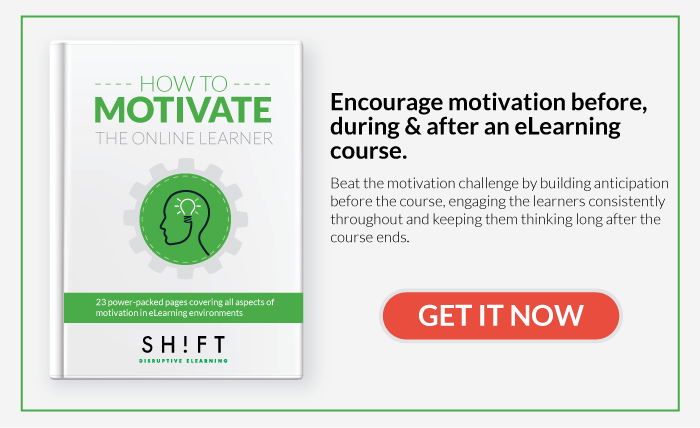Creating an amazing eLearning course is an exciting endeavor, but it's not without its challenges. The journey from concept to completion involves careful planning, strategic thinking, and a deep understanding of your audience's needs.
Whether you're devising an onboarding program, aiming to upskill or reskill your workforce, or developing courses for continuous learning, the preliminary steps you undertake are critical. These steps profoundly influence both the efficacy and the triumph of your educational endeavor.
As you stand on the brink of diving into the course's design and development, it's imperative to take a moment. Reflect on several pivotal aspects that have the power to either elevate your project to success or lead to its downfall.
Outlined below are six vital considerations to ponder before embarking on the creation of your eLearning course:
1) Conduct In-depth Audience Analysis
Start by diving deep into who your learners are. Getting a clear picture of their backgrounds, what motivates them, and their interests allows you to tailor your eLearning course more effectively. When the course aligns well with their needs, they're likely to engage more deeply, retain the information better, and apply what they've learned more effectively.
Here are a few key areas to focus on as you begin your research:
-
Experience and Background: Figure out if your learners are industry veterans or new to the field. Are they familiar with the topics you plan to cover? For those with a solid understanding, you might skip over the basics and delve into more complex areas, or perhaps streamline the content to keep it challenging yet engaging.
-
Tech Savviness: Assess their comfort level with technology. Are they adept at navigating new software, or do they tend to be more hesitant? This insight can help you decide if you need to integrate some basic tech tutorials at the beginning of your course.
-
Professional Level: Understand where they stand in their careers. Are they mid-level managers or senior executives? Tailoring the content to their professional level can make the learning experience more relevant and impactful.
-
Access Preferences: Consider how they will access the course. Will they use a desktop, a tablet, or a smartphone? Are they likely to need a VPN for secure access? Knowing this helps ensure that your course is accessible and user-friendly for everyone, no matter their preferred device or access point.
Read more: The 5 Best Ways to Research Your eLearning Course Target Audience
2) Identify Training Needs
Understanding the "Why" behind your course from the get-go is crucial. This clarity prevents learners from wondering, "Why am I here?" mid-course, ensuring that every module serves a clear purpose.
However, it's essential to differentiate between assumed needs and actual training necessities. An assumed need might not always warrant additional training. To pinpoint genuine needs, consider employing a variety of methods such as skills assessments, direct observation, surveys, or even focus groups.
For example, consulting with supervisors and line managers can provide invaluable insights into the specific training requirements that could significantly enhance performance. Their day-to-day interaction with your target audience places them in an ideal position to identify where training can bridge knowledge gaps or skill shortages.
Your aim should be to align the delivery of your eLearning courses with the actual needs of your employees, rather than scheduling training based on when it's most convenient for the organization.
To ensure your course is both necessary and timely, ponder the following:
-
Problem Solving: Will the eLearning course address a specific, identifiable problem within the organization?
-
Adaptation to Change: Are there impending changes such as new processes, equipment, or consistent shifts in staffing that necessitate re-training? Do updates in features, products, or services underline the need for updated training efforts?
-
Seizing Opportunities: Is there a chance to edge out competition by adopting new software or methodologies? Could the quality of customer service be elevated by introducing an eLearning course?
-
Proactive Initiatives: Could a proactive stance in training elevate overall performance levels? Would training aimed at enhancing quality standards contribute to increased productivity? Is there an opportunity to bolster a particular skill set through targeted training?
-
Compliance Requirements: Are there specific legal mandates or regulations that dictate the need for certain training programs to be conducted?
Delving deeply into the reasons behind the creation of your course ensures that the training you provide precisely meets the identified needs.
This approach not only maximizes the relevance and impact of your eLearning program but also reinforces the value of the training to both the organization and its employees.
Also read:
DON'T Skip the Training Needs Analysis! Here's Why.
6 Signs Your Employees Need Training, NOW
3) Think About the Type of eLearning Course You Need
After pinpointing the goal of your course and understanding your audience, it's time to consider the format and structure of your content.
Ask yourself: What's the purpose of the training?
Is it to ensure compliance, to introduce a new corporate social responsibility (CSR) initiative, or perhaps to provide a thorough exploration of complex topics? Maybe you're aiming for a lighter touch with a basic overview, or you might be focusing on practical examples to convey key concepts. Could the goal be to alter specific behaviors within the workplace?
Another crucial factor to weigh is the volume of content you have at your disposal. Are you working with an extensive amount of material that necessitates a lengthier course duration? Remember, if you're dealing with a broad topic that requires comprehensive coverage, consider breaking it down into digestible segments.
For example, suppose your objective is to boost engagement with a new recycling initiative. In that case, creating a connection with your learners on an emotional level is key. Storytelling, especially through videos or interactive narratives, can be much more impactful than traditional text-heavy courses. Such methods can evoke empathy and motivate learners to embrace recycling genuinely.
Considering the content's nature and your training goals, you might also explore microlearning courses. These are particularly effective for busy audiences as they deliver content in short, focused bursts, making it easier to absorb and retain information.
Choosing the appropriate format—be it in-depth modules, interactive storytelling, or bite-sized learning experiences—can significantly improve the effectiveness of your training program.
Also read: 7 Types of Training Programs You Should Convert to eLearning
4) Select the Appropriate Tools
In the evolving landscape of eLearning, selecting the right technology and tools is as crucial as the content itself. This step becomes even more significant when you consider the potential of AI-based eLearning tools to streamline and enhance the development process.
Consider how the chosen technology will serve your course's objectives and cater to your audience's preferences. Are you leveraging platforms that support interactive elements, such as quizzes and simulations, to engage learners? Does your technology choice facilitate easy updates and revisions to keep the course content fresh and relevant?
AI-based tools, in particular, offer a compelling advantage. They can dramatically speed up content creation, provide personalized learning experiences, and even offer predictive insights about learner outcomes. For example, AI-driven analytics can help identify patterns in learner behavior, enabling you to tailor content more effectively to meet diverse needs. Automated content generation tools can also assist in creating rich, interactive learning materials at a fraction of the time it would take manually.
Moreover, consider the scalability and integration capabilities of the technology. As your eLearning programs grow, you'll want a system that can grow with you, integrating seamlessly with other tools and platforms you might adopt in the future.
5) Organization and Planning
The effectiveness and overall success of your eLearning course are significantly influenced by the degree of organization and planning you invest upfront. Devoting time to meticulously plan your course is not just about laying out a roadmap; it’s about ensuring every element of the course is thoughtfully considered and aligned with your learning objectives.
Before you jump into designing your eLearning course, ensure you have thoroughly planned and organized the following elements:
-
Content Structure: How will you break down the content into topics and subtopics across different modules?
-
Engagement Strategies: Which activities and interactive elements will you incorporate to keep learners engaged and reinforce their learning?
-
Interactive and Multimedia Elements: What types of multimedia (videos, simulations, interactive graphics) will you include to enrich the learning experience?
-
Navigation and User Interface: How will the course navigation be structured to ensure a user-friendly experience?
-
Feedback Loops: What mechanisms will you put in place for providing learners with timely and actionable feedback?
-
Real-World Application: How will you integrate practical scenarios or real-life examples to enhance the applicability of the course content?
-
Content Sequencing: In what sequence will the content be presented to facilitate a logical and effective learning progression?
-
Communication Plan: How do you plan to maintain communication with learners throughout their learning journey?
-
Update and Revision Strategy: Have you considered how you will update and revise the content over time to keep it current and relevant?
-
Accessibility and Inclusivity: Have you planned for making your content accessible to all learners, including those with disabilities?
-
Logistics and Support: What logistical aspects need consideration, such as course access, learner support, and technical requirements?
This checklist can help ensure that all critical aspects of your eLearning course are addressed, leading to a well-organized and impactful learning experience for your audience.
6) How You’ll Evaluate Success.
Determining the effectiveness of your eLearning course is crucial for ensuring it delivers the intended outcomes. It's essential to identify the metrics and methods you'll use for evaluation early in the course development process.
Depending on your specific goals and requirements, your approach to evaluation might vary. If your course is designed to meet compliance regulations, you might need to adhere to strict evaluation criteria, such as administering a final exam or quiz. This type of assessment is effective for verifying knowledge acquisition and confirming that learners have achieved their learning objectives.
However, if your course offers more flexibility, you might explore alternative assessment methods. For instance, implementing a practical project or tracking course completion rates can provide insights into how well learners are applying the knowledge in real-world scenarios. Additionally, understanding your learners' demographics and motivations through surveys can offer valuable feedback and inform future course improvements.
Another powerful measure of success is the impact of the course on learner behavior. For example, in a safety training course, a key objective might be reducing the number of preventable injuries. By collecting, comparing, and analyzing injury data before and after the course, you can gauge the training's effectiveness in achieving this goal.
Customizing your evaluation strategy to align with your learning objectives simplifies the process of determining whether those objectives have been met. Establishing clear criteria for success from the outset ensures that you can effectively measure and enhance the impact of your eLearning initiatives.
Remember, the goal of evaluation is not only to confirm that learning has occurred but also to understand how that learning is being applied and its broader effects. For more insights on leveraging metrics to gauge the success of your eLearning course, consider exploring additional resources and articles on the topic.
For additional information on using metrics to measure your eLearning course success, see this article.
Now you’re ready to develop your eLearning course!
Consider these six elements before designing your eLearning course. Remember, the more relevant that course is to your target audience, the more it will resonate with them, and the better the outcomes for everyone.




